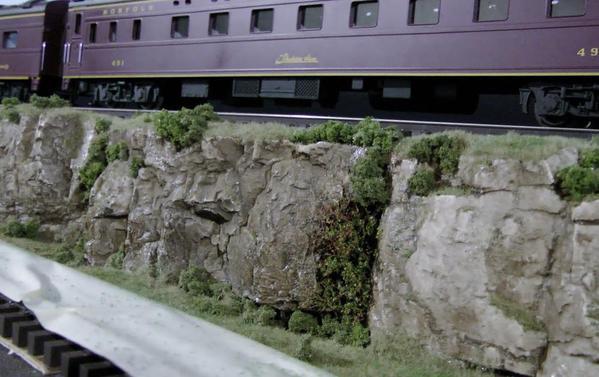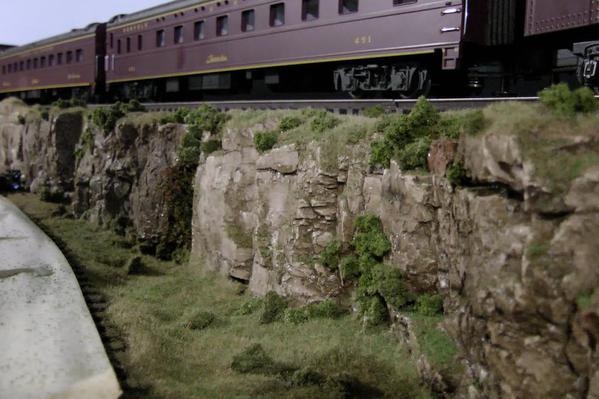I am new at the use of Hydrocal to mold rocks using Woodland Scenics rubber molds. I have a deep mold and 2 shallow molds. The Hydrocal is not getting firm. I put the water into the container and added the Hydrocal to the water, stirred slowly and then poured into mold. I had sprayed the molds with wet water and shook off the excess. I let it dry for 1-1/2 hrs before trying to remove them. They did not get as "warm" as I expected them to...but what do I know?? The deep mold at least came out in one piece but some of the detail came off. The thin smaller molds just broke into a bunch of pieces. I am soaking the molds in warm water to clean them and then will try again. Any suggestions?
Replies sorted oldest to newest
What was the consistency of the hydrocal mix? Sounds like you might have been a little short of the mix and long on the water.
Why the "wet water"? I've never needed it for hydrocal castings.
Other advise: practice, practice, practice. Rare is the one that gets it right the 1st time......
The Hydrocal is not getting firm. I put the water into the container and added the Hydrocal to the water, stirred slowly and then poured into mold...I let it dry for 1-1/2 hrs before trying to remove them...The deep mold at least came out in one piece but some of the detail came off. The thin smaller molds just broke into a bunch of pieces.
Hello Quiz,
I had similar experiences when I first started casting rocks with the Woodland Scenics Hydrocal and rock rubber molds. Here are some things to consider when preparing your batch:
- Mixture of Hydrocal to water. (I stick to the recipe. If the batter looks too runny, I'll add more Hydrocal a little at a time.)
- Humidity and room temperature. (I did my batches in January and my house was kept around 70 degrees. The drying time took over two hours. Eventually, I made a batch before I went to bed and let the castings dry in the mold overnight. On warmer days, I take my molds outside to sit in the sun.)
- For molds deeper molds and molds with multiple folds, shake a little more vigorously. (This helped the castings retain more detail, but I haven't made a casting yet that didn't lose a small amount of detail. I believe the wet water trapped in the deep folds mixes with the batter and that part then becomes unstable. Don't fret over the loss of detail as it adds character.)
- Time how dry the mold is with your eye. (I've made enough batches now that I can tell by looking at the back of the casting if more time is needed before attempting to remove the casting. The best example I can give is like looking at a piece of paper as it dries.)
- Let the casting sit in the mold for a longer time period.
Here's an example of some of the castings I have made.
Why the "wet water"? I've never needed it for hydrocal castings.
I went to the Woodland Scenic website for a refresher course. They have a new video up and in that one they do not mention using wet water for a mold release. I'll have to try a batch without it next time.
Attachments
It sounds like your Hydrocal is old and has been adversely affected by ambient humidity in the air. Hydrocal is very sensitive to the humidity in the air, which can affect it in as little as a couple of days once the seal on the package has been opened. If you are using the Woodland Scenics Hydrocal that is packaged in the containers that look like milk cartons and is sold in hobby shops, there is no way to know how long it has been sitting on the shelf, or what the humidity was when it was first packed up at the WDS facility.
Bill in FtL
possibly you are mixing in too much water. Also use the chip and pieces they work GREAT in filling in empty spaces
It's been a long time since I've done rock work. I don't believe the fact that you added the wet water it would have any effect. That's more to get the mold slippery to ensure the plaster gets into all the detail in the mold. Can't believe there's enough of a water presence to affect the mix. Sure sounds like you just got an old batch of plaster thats been sitting around for years. If it seems clumpy coming out of the container, it's not good. It should be a fine powder. Chances are it has some moisture in it from sitting or in how they transfer it to the container. It will never harden properly.I know it seems wasteful. You may be better off buying a large bag from a building supply house that moves a lot of product. You will be sure it's fresh. I use to mix. Two parts plaster. To 1 part water. Stirred well. Never used hydrocal. Used generic plaster the contractors used. Always got consistent results. If the plaster doesn't seem right. Tossing it is not a big hit money wise. The hobby stuff is priced more from a packaging point for small jobs and has to retail for a lot more. There are a lot of fancy names as far as plaster and what to use. Talk to someone at a good supply house that knows his stuff and explain to him what your trying to do. He should be able to get you set up with a product that works.
We don't make hydrocal, but do plaster of Paris. they're similar. Mixing ratio is important. Too much, or too little water will create problems. Don't mix too large of a batch, 2, or 3 cups of powder is a good amount, with right mix of water. The initial mix of both, when properly measured will look too funny, that's normal. The chemical additive creates heat to cure, and it'll thicken quickly.
Biggest cause of problems is mixing too large of a batch, and improper mix ratio, powder to water.
I've been using they other guys hydrocal rather than our p.o.p fur layouts for years.
I would not use any "wet water" I have casted hundreds of rocks with out any problems. The molds should definitely get warm as the curing takes place so if it isn't then either the ratio is off or the batch is bad. I was removing these rocks after 30 minutes in the mold.
Attachments
Wet water is not the problem. I always use it on every Hydrocal pour. Your problem is old Hydrocal. Pure and simple. It's past it's time. Hydrocal will cure perfectly even if mixed soupy or too thick. Get a fresh bag and try again. Keep in a dry place and not over six months. It should be able to be removed from a mold in about an hour or so. If it won't come out perfectly with an hour and a half of cure time, it's bad Hydrocal. i've used Hydrocal since 1975 with no problems. And I always use wet water for each mold. Try again.
Here's some info on casting with Hydrocal....from one of our manufacturers, C.C.Crow...
In the section "Mixing the Hydrocal", there is a comment regarding 'old' Hydrocal. Like many of the plaster species, it will snatch moisture from the air over time, especially if stored in a container with less than a tight-fitting cover. You'll notice, too, in the preceding paragraph on "Preparing the Mold" that he uses 'wet water', or a version of the same.
Hey, these are the guys that do this commercially. I think they've graduated from the School of Hard Knocks. The advice is free. I'd go with it. Get some fresh Hydrocal. Store the unused in a better container...maybe with a small container/package of dessicant.
Be thou not discouraged, bro'. We've been through these trials, too. Verily, verily.![]()
![]()
Thanks for all the help. I combined all the advice, shake container of Hydrocal for 30 seconds or longer, closely monitored mixing instructions, no wetting agent, let it cure longer in the mold, try try again. I am getting better results. But I did get the Hydrocal at the LHS, in a "milk container" like box and it was on "sale" with 2 pricing stickers under the one on top...maybe a few years old. Next time I will get fresher product and store it in airtight container.














